What Type Of Animal Is An Iguana
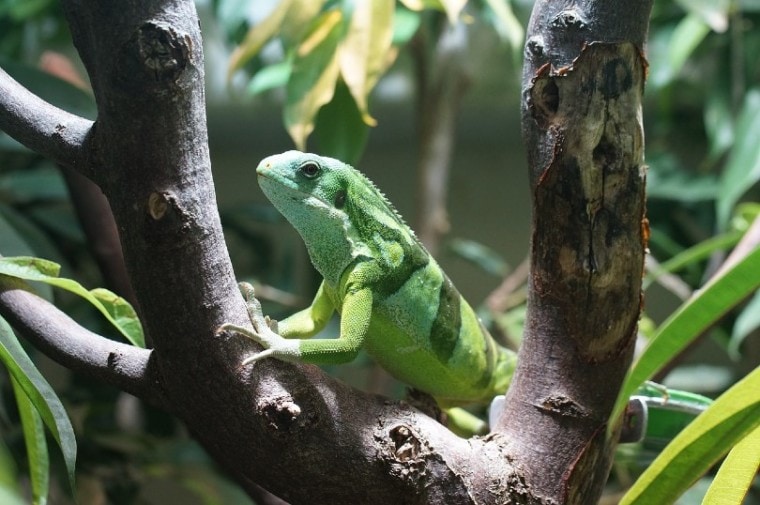
Iguanas are herbivorous lizards native to tropical areas of N, Fundamental, and South America, and the Caribbean. These intelligent and cute creatures come in a variety of shapes and colors and can range in size from a few inches to over six anxiety in length.
Iguanas live on land, in rocks, and copse. They have a dewlap and a stripe of elongated scales running from the middle of their necks down to their tails. Iguanas use their tails for balance when they climb and for self-defence force. When an iguana feels threatened, information technology will distract and bewilder a predator or other threat by thrashing its tail.
One of the most interesting things about iguanas is that their muscles substantially become paralyzed and they fall into a land of hibernation when the temperature drops beneath 40 degrees Fahrenheit. This is a rather rare occurrence in hot tropical climates similar what's common in Central America but tin happen in locations like southern Florida where they've been introduced by humans.
At that place are dozens of different species of iguanas. Here are 10 types of iguanas including a few that are endangered.

The Acme x Most Common Types of Iguanas:
1. Green Iguana
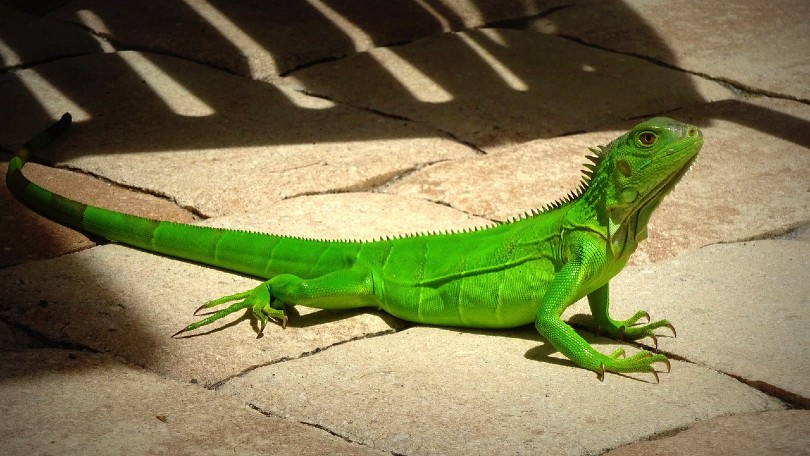
The Dark-green Iguana is the most common species that can grow to five to seven anxiety long. These iguanas are often kept as pets. If yous're thinking of getting a Green Iguana, you must provide it with a large muzzle, high temperatures, and humidity.
As herbivores, Dark-green Iguanas only consume greens, flowers, vegetables, and fruits. While it is native to Brazil and Paraguay, the Green Iguana is also found every bit far n as United mexican states. There are even some feral populations of Green Iguanas living in South Florida, Hawaii, the U.S. Virgin Islands, and the Rio Grande Valley of Texas. As you may have guessed, Green Iguanas are dark-green and often have blotches and stripes of other colors including orange, blue, black, and white. These iguanas as well have spines along their back, big dewlaps under their chins, and prominent jaws.
2. Cuban Rock Iguana
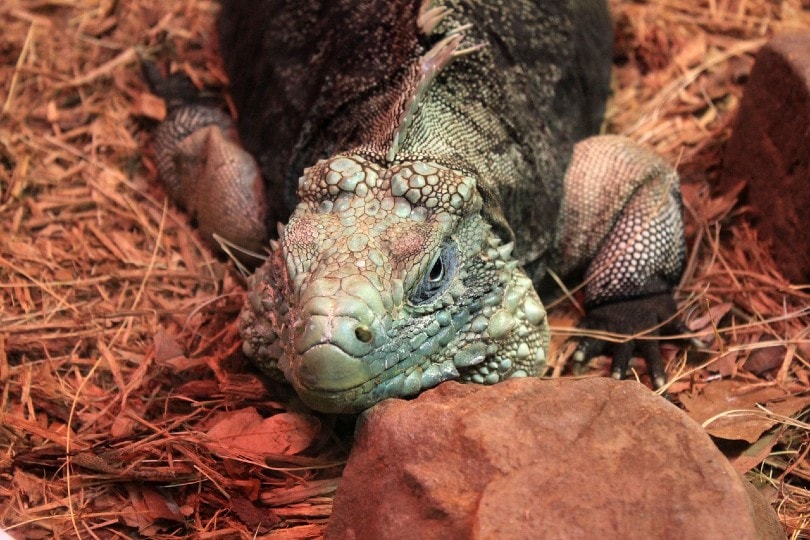
The Cuban Rock Iguana lives in colonies all across Cuba and nearby islands. This is a footing-dwelling iguana that grows to lengths of around five feet and can live for 50 years or more. This iguana is like shooting fish in a barrel to tame but it requires a large outdoor enclosure with basking areas. This lizard has to be handled carefully because it has very powerful jaws that can practise some great damage to fingers or toes.
Cuban Rock Iguanas are dark chocolate-brown or green with dark bands of color on their bodies. The males are dark gray to brick red while most females are olive greenish with dark stripes or bands.
three. Desert Iguana
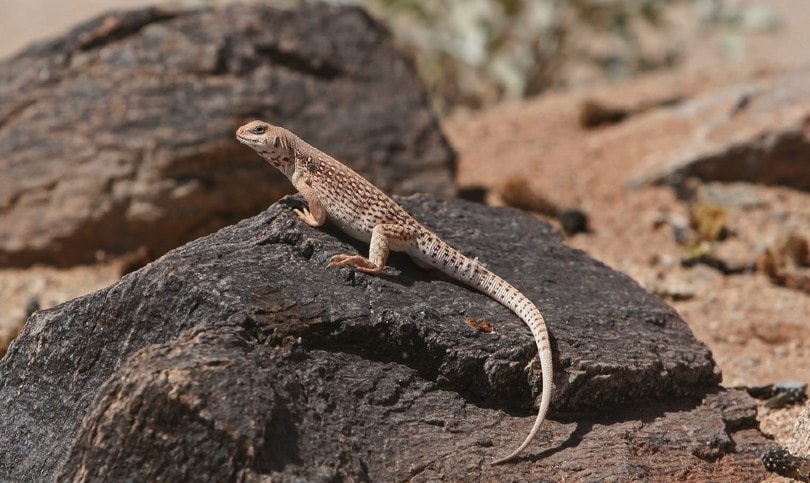
Native to arid portions of Mexico, California, and Arizona, the Desert Iguana lives a different lifestyle than its light-green relatives that spend their days clinging to trees in tropical areas. This lizard that only grows to lengths under two feet, spends virtually of its time on the desert floor and bordering rocks.
These lizards are colored white and night grey with blood-red-brown tones. This type of iguana is difficult to keep as a pet because it tin flatly refuse to eat, even if offered something irresistible similar edible flowers.
4. Rhinoceros Iguana
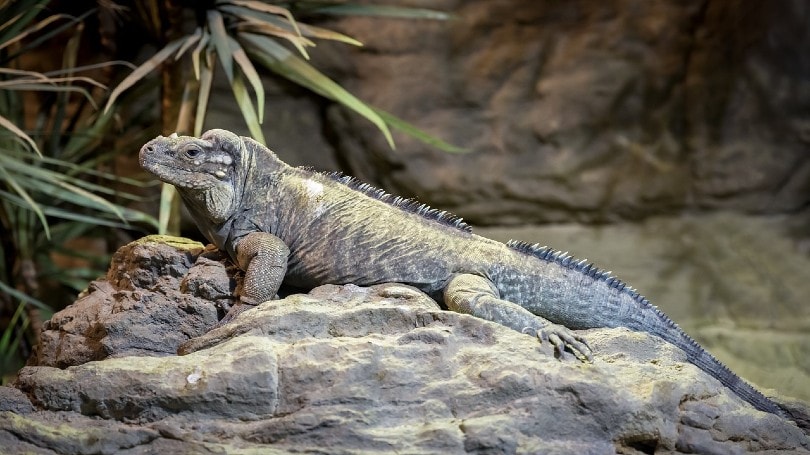
The Rhinoceros Iguana gets its proper noun from the horn-like protrusion growing on the snouts of males. These iguanas are a species many people desire to own due to their magnificent appearance.
Native to Republic of haiti and the Domincan Republic, Rhinoceros Iguanas adopt dry rocky forested areas along coastlines. These iguanas have drab coloring in grayish brownish to blackness colors so they can easily hide from predators in their native environs.
Rhinoceros Iguanas can be extremely aggressive, although their temperaments vary between individuals. These iguanas can alive for longer than xx years.
five. Northeastern Spiny Tail Iguana
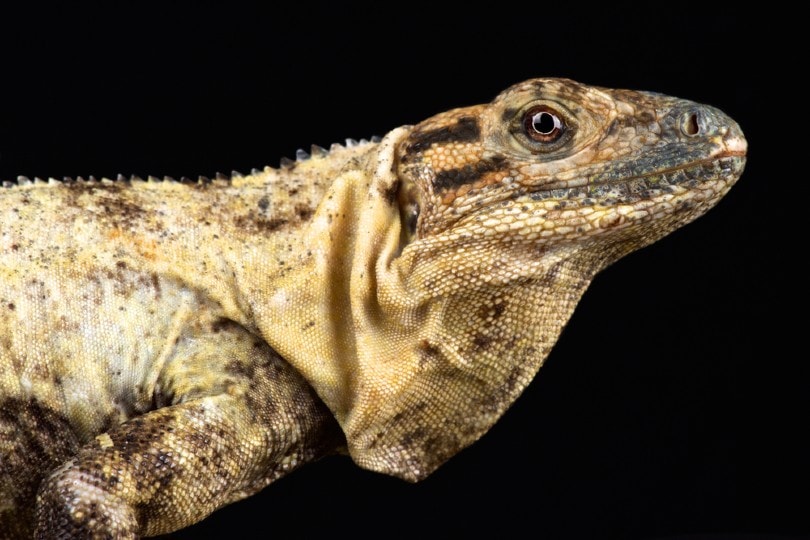
Endemic to Mexico and Guatemala, Northeastern Spiny Tail Iguanas accept distinctive keeled scales on their long tails. These lizards are splendid climbers and prefer living in a rocky habitat with many crevices to hide in, rocks to bask on, and nearby trees to climb.These fast-moving iguanas are primarily herbivorous, eating fruit, flowers, leaves, and stems. They will also eat smaller animals, eggs, and anthropods if given the opportunity.
Named for the keeled scales covering their long tails, Northeastern Spiny Tail Iguanas can grow upwardly to lengths over three feet long. These iguanas are nervous, flighty, and defensive and they won't think twice well-nigh biting.
If kept equally pets, Northeastern Spiny Tail Iguanas should live in large vertical enclosures so they accept plenty of room to climb.
6. Chuckwallas
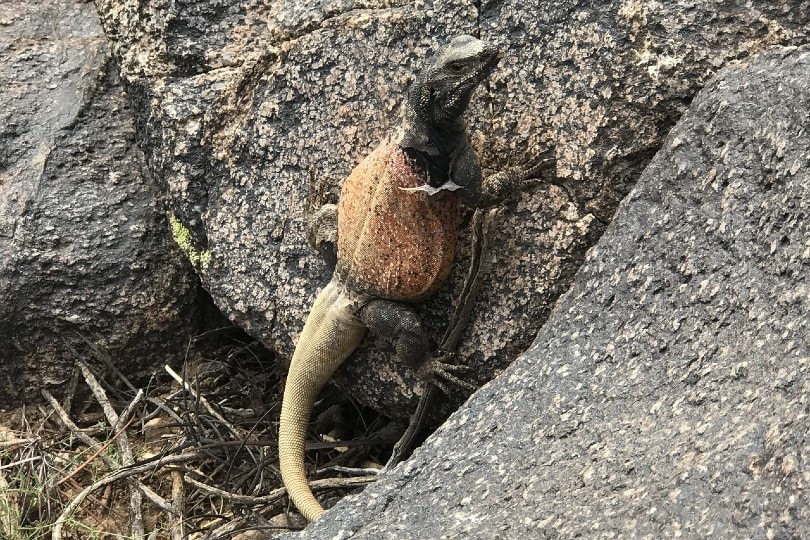
Native to the barren western portions of Northward America, Chuckwallas prefer living amid rocks. When frightened, they will seek shelter amidst the rocks and can wedge themselves into tight spaces and fill their bodies with air. This makes it very hard for a predator to access and extract these lizards.
Chuckwallas have stocky bodies and tin can reach lengths of nearly 18 inches. They can exist kept in captivity by experienced keepers as long as they're provided with a rocky habitat with enough of room. These are gray iguanas with lighter-colored blotches all over their bodies.
Chuckwallas are omnivorous which means they tin consume a varied diet of vegetables, seeds, and insects. They can be fed a strictly herbivorous diet if kept as pets.
7. Republic of the fiji islands Banded Iguana
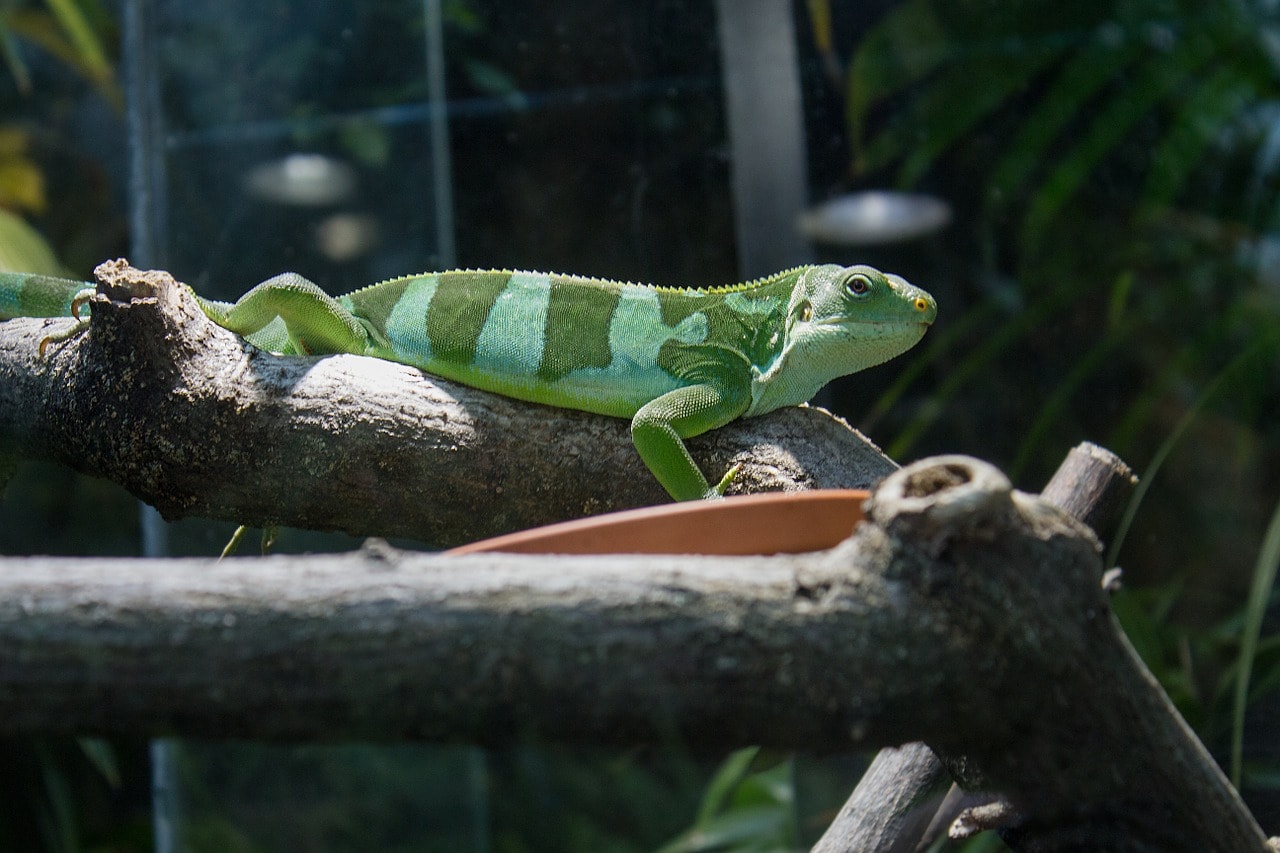
This blazon of iguana is a real beauty with its stunning brilliant light-green color, crested spines, and long tail. This is an endangered species institute exclusively on the Fiji Islands. While the females are solid-colored, the males have blue or greenish stripes.
These arboreal lizards spend most of their time in trees. That'due south why they are typically plant in areas with high vegetation and copse at least xx feet tall. These iguanas can abound to 7.5 inches in length.Fiji Banded Iguanas are first-class swimmers that prefer living in wet forests, spending most of their time foraging for leaves, flowers, and fruit. On the rare occasion, a Republic of the fiji islands Banded Iguana will eat insects. These beautiful iguanas live up to xv years in the wild and 25 years if raised in zoos.
eight. Marine Iguanas
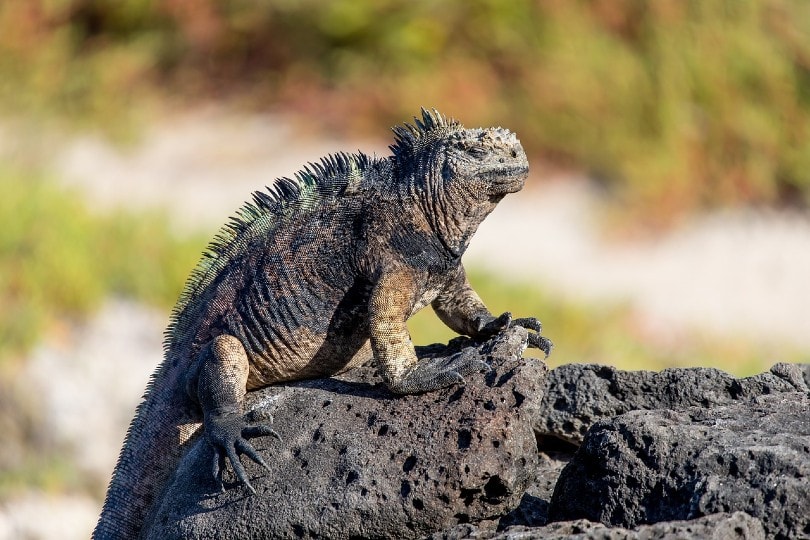
Every bit the just type of Iguana that's found in the Galapagos, the Marine Iguana is an endangered species. This iguana is the world's simply oceangoing lizard that can be seen resting on rocky shores.
Growing upwardly to six feet long, Marine Iguanas are striking creatures with thickset bodies and short, robust legs. The adults take a row of spines extending from the cervix to the tail. Marine Iguanas can be black or grey with lighter-colored dorsal stripes. The developed males tin can become brighter in color when breeding.
These marine reptiles provender for algae in the sea, which makes upwards nigh of their diet. Marine Iguanas can dive deep to observe algae. These iguanas alive in colonies on rocky shores where they bask in the sun after swimming in the cold water.
9. Jamaican Iguana
The Jamaican Iguana is Jamaica'south largest native animal species. This lizard is critically endangered as it faces many threats including invasive species and a loss of habitat.
Growing to a length of two feet, this iguana is a dark gray, blue, or dark-green-colored reptile with a long tail and triangular stripes downwards the length of its back.
While Jamaican Iguanas used to be constitute on many southern coastlines in Jamaica, today they're only found in a location known as Hellshire Hills. This is a dry forested expanse full of a variety of rocks including limestone.
With its long toes and sharp claws, a Jamaican Iguana can climb loftier into trees to swallow leaves, fruit, and flowers. These mainly herbivorous iguanas will also eat insects, snails, and other small animals when available.
You lot May Besides Similar:Westward Indian Rock Iguana
10. Bahamian Stone Iguanas
Bahamian Rock Iguanas are amidst the most endangered lizards in the world. These chocolate-brown pink iguanas with the distinctive thick-ringed tail can abound up to three feet in length and can exist found on diverse islands throughout the Commonwealth of the bahamas. This iguana is important to the people of the Bahamas and is linked to the country's number one manufacture which is tourism. Many people visit the Bahamas for both its beauty and to see the Rock Iguanas in their native environment. Bahamian Rock Iguanas are herbivorous, consuming leaves, flowers, berries, and fruits. These lizards accept long straight tails and brusque powerful limbs which helps them climb copse and rock formations. These impressive-looking iguanas are surprisingly skilful saltwater swimmers.
You may likewise be interested in:
- Are Iguanas Endangered?
- Fiji Banded Iguana
- Do Iguanas Change Colour?
Featured Image Credit: Marcel Langthim, Pixabay
Source: https://petkeen.com/types-of-iguanas/
Posted by: thralltivent.blogspot.com

0 Response to "What Type Of Animal Is An Iguana"
Post a Comment